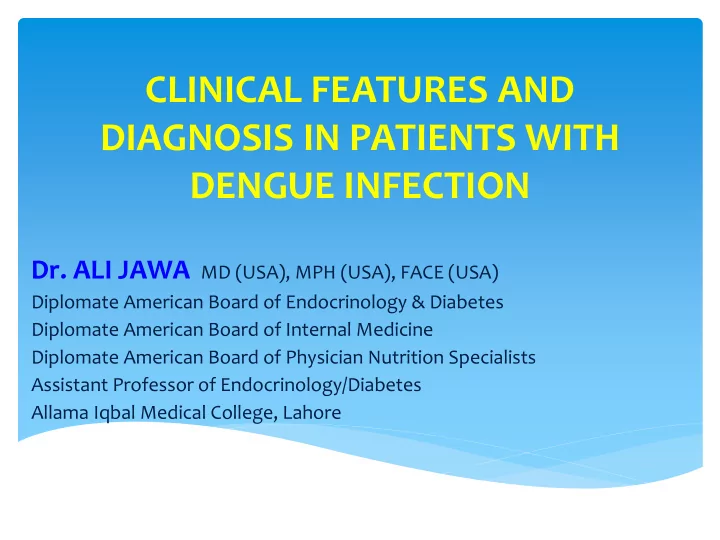

CLINICAL FEATURES AND DIAGNOSIS IN PATIENTS WITH DENGUE INFECTION Dr. ALI JAWA MD (USA), MPH (USA), FACE (USA) Diplomate American Board of Endocrinology & Diabetes Diplomate American Board of Internal Medicine Diplomate American Board of Physician Nutrition Specialists Assistant Professor of Endocrinology/Diabetes Allama Iqbal Medical College, Lahore
DENGUE VIRUS SEROTYPES DENV DENV 1 2 DENV DENV 3 4
Dengue virus Short term Life long cross- immunity protection DENV DENV 1 2 Short term Short term DENV DENV cross- cross- 3 4 protection protection
Clinical Course of Dengue Infection Yip WCL. Dengue Haemorrhagic Fever: Current Approaches to Management. Medical Progress October 1980.
Dengue Virus Infections WHO 2011 Classification System Dengue Virus Infection Symptomatic Asymptomatic Dengue Dengue Expanded Dengue Undifferentiate Fever Hemorrhagic Syndrome/ Isolated d Fever Syndrome organopathy/ Unusual Fever manifestation Without Dengue Shock With Unusual No Shock Hemorrhage Syndrome Hemorrhage
Case Definition for Dengue Fever Probable Confirmed Reportable
DEAG Case Definition Suspected Probable Confirmed
Suspected
Probable
Confirmed
Febrile patient (2-10 days) Out-patient department Emergency department Suspected Case CBC Probable case REPORT Admit Day 2-5 Day 6-10 NS-1 antigen IgM Confirmed case
Less than 5 days More than 5 days
PROBABLE DENGUE FEVER (2011) An acute febrile illness with two or more of the following manifestations: Headache Retro-orbital pain Myalgia Arthralgia Rash Hemorrhagic manifestations Leukopenia Thrombocytopenia (less than 150,000) Rising Hct (5-10%) And • Supportive Serology ( a reciprocal Hemagglutination-inhibition antibody titer ≥ 1280, a comparable IgG ELISA titer or a positive IgM antibody test on a late acute or convalescent-phase serum specimen) Or • Occurrence at same location and time as other confirmed cases of dengue
DENGUE FEVER/DHF Differential Diagnosis Arboviruses Chikungunya Measles; rubella and other viral Other viral exanthems ; Epstein-Barr Virus, Diseases Enteroviruses, Influenza; hepatitis A, Hantavirus Bacterial diseases Meningococcemia, leptospirosis, typhoid , melioidosis, rickettsial diseases, Scarlet fever Parasitic diseases Malaria
CONFIRMED DENGUE FEVER A case confirmed by laboratory criteria Isolation of Dengue Virus from serum or Autopsy Sample ≥4 fold rise in IgG or IgM antibody titres in paired serum samples Demonstration of Dengue Antigen in autopsy specimen, serum or CSF Detection of Dengue Virus Genomic Sequence by PCR
REPORTABLE DENGUE FEVER Any probable or confirmed case of dengue should be reported to Health Department and requires admission to the hospital
DHF vs DF Febrile Phase Febrile Phase Critical Phase Critical Phase Recovery Recovery Phase Phase
CASE DEFINITION FOR DENGUE HEMORRHAGIC FEVER The following must ALL be present: Fever, or h/o acute fever, lasting 2-7 days, occasionally biphasic Hemorrhagic tendencies , evidenced by at least one of the following • A positive tourniquet test • Petechiae, ecchymoses or purpura • Bleeding from mucosa, gastrointestinal tract, injection sites, or other locations • Haemetemesis or malena Thrombocytopenia ( ≤100,000 per mm 3 ) Evidence of Plasma Leakage manifested by at least one of the following • A rise in Hct ≥20% above average for age, sex and population • A drop in Hct ≥20% after volume -replacement treatment • Signs of plasma leakage such as pleural effusion, ascites and hypoproteinemia
CASE DEFINITION FOR DENGUE SHOCK SYNDROME All of the four criteria of DHF plus evidence of circulatory failure manifested by: • Rapid and weak pulse, and • Narrow Pulse Pressure ( ≤ 20 mmHg) Or manifested by • Hypotension for age, and • Cold, clammy skin and restlessness
EXPANDED DENGUE SYNDROME Organopathy in the setting of acute dengue virus infection Liver failure Mononeuropathies central nervous system Polyneuropathies Guillain-Barré syndrome (CNS) dysfunction myocardial dysfunction transverse myelitis encephalopathy and myocarditis seizures acute pure motor weakness
EXAMINATION Tourniquet test Pulse (Bradycardia, Tachycardia in an afebrile patient) Blood Pressure Pulse Pressure Temperature Capillary refill time
INJECTED PHARYNX
PETECHIAL RASH
SUBMUCOSAL HEMORRHAGE
BRUISING
CAPILLARY REFILL TIME
TOURNIQUET TEST
TOURNIQUET TEST
TOURNIQUET TEST Positive TT serves as the only indicator of hemorrhagic tendency in grade 1 DHF. The sensitivity of the test varies widely from as low as 0% to 57%, depending on the phase of illness the test was done and how often the test was repeated, if negative. In addition 5-21% of patients with dengue like illness had positive tourniquet test but subsequently have negative dengue serology Level of Evidence Reference Level 1 Badyopadhyay S, Lum LCS, Kroeger A. Classifying dengue: a review of the difficulties in using the WHO case classification for dengue haemorrhagic fever. Tropical Medicine and International Health. 2006; 11(8):1238-55.
TOURNIQUET TEST A recent study demonstrated that there was 95.3% positive predictive value if fever, positive tourniquet test, leucopenia/ thrombocytopenia/ hemoconcentration were used as screening criteria. Presence of ≥10 petechiae per square inch should be considered positive. Level of Reference Evidence Level 8 Kittigul L, Pitakarnjanakul P, Sujirarat D, et al . The differences of clinical manifestations and laboratory findings in children and adults with dengue virus infection. J Clin Virol. 2007 Jun;39(2):76-81.
TAKE HOME MESSAGE Dengue Fever and DHF could be indistinguishable at the time of presentation All probable am d confirmed dengue fever cases need to be admitted and reported to health department Careful attention physical signs and symptoms as well as appropriate and timely laboratory tests are key to diagnosis
Thank You
Recommend
More recommend